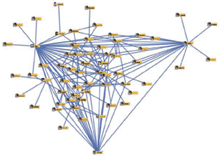Soon after the U.S. invaded Iraq there were a few comments in the press about the large numbers of boys and men who were being thrown in jail and allowed no communication with anyone for months. Military sources acknowledged that most of these detainees were not militants. Then the press stopped talking about it. In July 2009 Science Magazine revealed one reason for these arrests: interrogation of the innocents provide a data base that, with the help of computers, reveals where the real terrorists are. Apparently the dubious value of this data base is deemed to outweigh the liability of making people despise the U.S. For more on abuse of civilians by the U.S. military read "Winter Soldier, Iraq and Afghanistan." And there is a Winter Soldier video about Vietnam, but it is not free on the internet, you have to buy it.
Science Magazine
July 24, 2009
News:
Investigating Networks: The Dark Side
|
A few months ago, Lawrence Wilkerson, a former U.S. State Department official and Army colonel, painted a nightmare scenario of how social network science can be applied in a battle zone, outlining something he called "the mosaic philosophy."
A few months ago, Lawrence Wilkerson, a former U.S. State Department official and Army colonel, issued a scathing criticism of how the United States has conducted war in recent years. He also painted a nightmare scenario of how social network science can be applied in a battle zone. Describing how U.S. forces gathered intelligence to identify networks of insurgents after the 2003 invasion of Iraq, Wilkerson outlined something he called "the mosaic philosophy." The strategy, he claims, was similar to sequencing a genome. But instead of assembling millions of strands of DNA, investigators worked with data from interrogations of thousands of civilian prisoners.
Wilkerson wrote in a 17 March 2009 article at The Washington Note—a political commentary Web site—that the U.S. military relied on network analysis "computer programs" so that "dots could be connected and terrorists or their plots could be identified." Now based at the New America Foundation, a think tank in Washington, D.C., Wilkerson wrote that "it did not matter if a detainee were innocent." According to Wilkerson, the objective of the mosaic approach was to "extract everything possible ... to have sufficient information about a village, a region, or a group of individuals. ... Thus, as many people as possible had to be kept in detention for as long as possible to allow this ... to work."
Wilkerson told Science that his allegation is based on "classified documents to which I had access from 2000 to 2005" as chief of staff for former U.S. Secretary of State Colin Powell. He puts the total number of people detained in Iraq and Afghanistan at 50,000. He says he does not know which computer program or researchers were involved. The U.S. Department of Defense declined to comment. The allegation could not be independently verified.
The general strategy of casting a wide net for intelligence gathering was familiar to all network researchers contacted by Science (see main text), but many expressed disbelief that it was carried out on such a grand scale in Iraq and Afghanistan. "Very scary if true," says Marc Sageman, a network researcher and longtime U.S. military contractor, but it would be "incredible." He adds that it would never work, even if it were tried.
Researchers who create network analysis computer programs have had similar reactions. Software engineers at one of the industry leaders, Palantir Technology in Palo Alto, California, say they had never heard of such abuses. And Wilkerson's "computer program" could not have been theirs, says Palantir CEO Alexander Karp, because the company only recently started courting the U.S. military for contracts. "If we ever learned that something like this was going on, we would immediately pull out," he adds.
Only one researcher contacted by Science had heard of the mosaic philosophy. "It's not a term used in academia. It's used in the military," says Kathleen Carley, a computer scientist at Carnegie Mellon University in Pittsburgh, Pennsylvania, who does network analysis research for the U.S. military. "I am not part of the mosaic thing." Carley does not dismiss the strategy as ineffective. Without knowing exactly how the interrogations and data analysis were carried out, she says, "I don't think you can decide whether it's unworkable or not."
Asked if the mosaic philosophy is actively applied by U.S. military or intelligence agencies, Wilkerson says emphatically that it is not. Revelations about the torture of prisoners by U.S. forces have "caused the pendulum to swing the other way," he says. "The only place I still hear about its applicability and possible use is at the [National Security Agency]. ... There, its use is to mine huge databases comprised of information gained from e-mails and telephone calls."
"Is this the dark side of networks? ... I think it probably is," says Brian Uzzi, a network scientist at Northwestern University in Evanston, Illinois. "All powerful methods grow a dark side. Their power is eventually used irresponsibly. I think the real fear here is that a method that has a reputation for finding new insights is falsely used."

